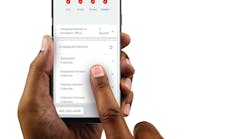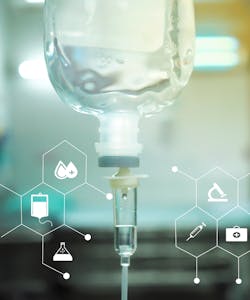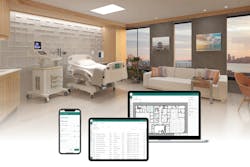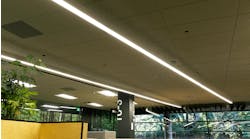How Lighting Helps to Prepare for the Future Integration of IoT Sensors
Lighting accounts for an average of 35% of the total energy in a building and upgrading to LEDs can provide more than 50% in energy savings. If you add a control system, this can provide an additional 25% in savings, bringing significant value to your bottom line.
Typical lighting control systems allow you to control a building’s lighting – from adjusting light levels to providing a more comfortable and productive environment to turning the lights off and on based on occupancy. Advanced lighting control systems go beyond just controlling the lights by allowing the gathering of data, bringing 10 to 100 times more value to the end-user.
Data provides value
Data is defined as “pieces of information, usually formatted and stored in a way that is concordant with a specific purpose.” In the context of lighting, we are talking about the data collected around the areas surrounding the luminaires, which is communicated to a local or remote server, then analyzed and shared with other systems, providing useful insights for the customer.
About a decade and a half ago, manufacturers realized LEDs could be controlled without a significant impact on the lamp life or the ambient lighting comfort. LEDs could provide energy savings and be controlled for specific tasks and activities. The easiest and most efficient well-known solution to achieve this is with occupancy sensors and daylight sensors. But what if we can get such data for an entire floor, building, or campus of buildings? This might be data that can tell us how often a room is entered or how many cars are currently on a parking garage floor. How many customers went into the store today, and what portion of the parking lot is used at night? And is anyone still in the local park when it's closed? This valuable data can be collected, analyzed, and communicated to learn much more about a site.
This is what happened when lighting manufacturers started networking/connecting the lights to accurately control or group luminaire behaviors based on installing single/multiple sensors within the fixtures. A decade ago, lighting manufacturers introduced luminaires with radio devices (such as the Zigbee local wireless network or 4G cellular communication) to control luminaires remotely. Lighting software started analyzing occupancy information and created useful information, beyond just lighting control.
Since lighting is everywhere, when grouped under a network, it can then be used as a conduit from end-users to devices for valuable information. Asset tracking, contact tracing, and wayfinding are a few examples of how advanced lighting control systems are being used beyond controlling the lights. As an example, a building's HVAC, fire alarm, and lighting system can use the same signal to turn off air intake and turn on all lights when the fire alarm is activated. The benefit of such information/signals gets even more valuable when shared with other manufacturers.
For example, you can share control of a room’s temperature using lighting control wall stations, or a demand response signal can be set up from the local electric utility to dim lights. This type of system will not only provide additional energy savings, but more importantly in some locations, it also satisfies a requirement to be code compliant. Such an ecosystem provides manufacturers' and industries' IoT products a backbone for advanced data and information at the heart of IoT. Air quality, structure vibration, and space utilization heatmaps are some examples of IoT applications.
Evaluating the value of data
How can you evaluate the true value of the data? There aren’t many cases or projects showing the true value of such an ecosystem. For example, what is the true value of having lights fully turned on when the fire alarm is on? Or how many more customers made their way to the store with a wayfinding system? With that being said, we do know of some well-proven cases.
One example is asset tracking of hospital equipment, such as IV pumps. Hospitals are relatively large facilities and have a significant amount of mobile equipment in use daily. This equipment needs to be found, cleaned, and maintained. You might be wondering how they keep track of it. In most cases, they don't. Many times, to support their daily operation, they buy or rent more equipment. It is estimated that IV pumps are only utilized at 35% or less — even with the extra supply. This scarcity of equipment creates a vicious cycle to the point that a nursing staff member may hide equipment to serve their patient better, often resulting in equipment “getting lost or forgotten.”
With a real-time locating system (RTLS), critical equipment is "tagged" with an asset ID, which allows it to be located in the hospital from sensors embedded in a luminaire. This information is sent through the lighting control network to a server and then shared with a third-party system, such as a BioMed equipment maintenance software. The equipment’s cleaning circle, maintenance, and distribution between the hospital department and floors are optimized. With an RTLS and data on the asset and its location, it is estimated that IV pump utilization could be improved up to 75%. Solely from asset tracking, hospitals could save more than $500,000 per year, resulting in a less than a year return on investment (ROI).
Leveraging your current network
What is the next step for the lighting industry to help customers leverage their lighting networks? We need to "open" our lighting infrastructure and network to other manufacturers. There are so many new fields of expertise that one manufacturer can't support them all. To provide a sustainable solution, we need to offer guidance on the mechanical, electrical, and communication equipment to be used with luminaires. There are several initiatives underway to help accelerate and simplify sensor integration and communication for sensor manufacturers.
One example is an indoor and outdoor luminaire sensor interface standardization and certification (D4i). According to the DALI Alliance, D4i (an extension of the DALI-2 certification program) is the DALI standard for intelligent, IoT-ready luminaires. D4i LED drivers have a mandatory set of features related to power-supply requirements and smart-data capabilities. Smart D4i luminaires are ideal platforms for the IoT, capable of gathering information from onboard D4i sensors and providing data for performance monitoring, asset management, predictive maintenance, and many other tasks.
Looking to the future
For customers looking to improve their operations with new smart devices, leveraging their lighting infrastructure is often the easiest path. An upgradable infrastructure helps specifiers and customers prepare the site for future technologies. It will help the installer to test and replace products when they present signs of underperformance.
In addition, upgradable and scalable lighting products have recently been launched by reputable manufacturers and should become part of standard project requirements. Specifiers should consider these options if their customer is interested in network and IoT solutions but are not quite ready to make the jump today. These future-ready luminaires, for which sensors and controllers can be upgraded later, are the new 0V to 10V dimmable LED driver of 10 years ago. They'll simplify a customer's future steps into using data to improve their city/facility/building efficiently and their costs effectively.
Since these systems are relatively new, a good understanding of D4i is required when working on specifying a solution for a new project. Self-education and open discussion with manufacturers will help you fully understand the best D4i solution and to prevent issues when deployed. Every project is different, so it can also be a learning experience for the manufacturer, who may need to adapt the system to an unforeseen specific application. This same open discussion should take place for in-field installation. Before the system technician visit, the installer needs to make sure the wiring, lighting connectivity, and network connectivity are in place.
Again, I encourage everyone to become educated on the topic before getting involved in this type of project. Once the opportunity to deploy such an ecosystem arises, create a functional mock-up with the customer and involved manufacturers. Most unforeseen challenges can be detected at a smaller scale and resolved before installation, significantly lowering cost and the time invested by specifiers, contractors, and manufacturers.
Martin Mercier, P.Eng., is strategic marketing manager for IoT and connected systems for Cooper Lighting Solutions, a division of Signify, based in Peachtree City, Ga. He can be reached at [email protected].







